
The Complete Guide to Building A SaaS CMO Dashboard
Tracking campaign performance across marketing channels can be a tedious and unintuitive process. CMOs often have to rely on individual department reports to gather a summary of how the team is performing – an endeavor that leaves many gaps and relies heavily on guesswork.
In addition to the time it takes to compile reports, derive actionable insights, and chart next-steps, the traditional way of doing things is prone to several manual errors.
The solution? The perfect CMO dashboard that helps streamline your work based on relevant analytics and metrics under one roof.
This article shows how powerful CMO dashboards can be used to drive data-driven business decisions.
TL;DR
- CMO dashboards offer a holistic view of customer data-related metrics and KPIs through intuitive visualizations.
- The benefits of SaaS companies using CMO dashboards include rapid decision-making, sensible use of time and resources, improved ROI, and unified visibility of marketing performance.
- Before you build a comprehensive CMO dashboard, pay close attention to user-friendly design, use helpful visualizations, integrate platforms to consolidate data, and measure the right metrics/KPIs.
- SaaS businesses must track metrics/KPIs such as conversions, leads, traffic, conversion rates, acquisition cost per channel, retention and churn rates, customer lifetime value, and revenue and pipeline velocity by channel source. A CMO dashboard helps visualize these metrics and KPIs with clarity.
What is a CMO dashboard?
A CMO dashboard is a tool that reports and visualizes KPIs and metrics related to a company's marketing activities across demand gen, content, paid, events, and more. It is a centralized, bird’s eye view that helps marketing executives monitor and analyze marketing initiatives and performance in real-time.
There is no hard and fast rule to building a CMO dashboard for your SaaS company. That being said, there are certain elements that are essential for marketing leaders to identify patterns, track progression, and optimize strategies to drive bottom-line business objectives.
We’ll explore these essential ingredients in later sections of this blog.
Why do CMOs need to use dashboards?
Here’s a look at the top benefits of using a well-designed CMO dashboard:
1. Improves decision-making
When making expensive business decisions, relying on guesswork can cost you heavily. CMO dashboards help marketing leaders make well-informed and accelerated decisions based on data-driven insights.
For example, a CMO dashboard can help you identify which channels and marketing campaigns are not performing if you're making budget-related decisions. It also enables you to identify the reason behind poor campaign performance and the following steps to be taken.
Let's say you have the company blog, paid advertising, and podcasts as key marketing channels. A deep dive into the dashboard will help you uncover how much revenue each channel can generate, the cost of leads from each touchpoint, and how long it typically takes them to convert.
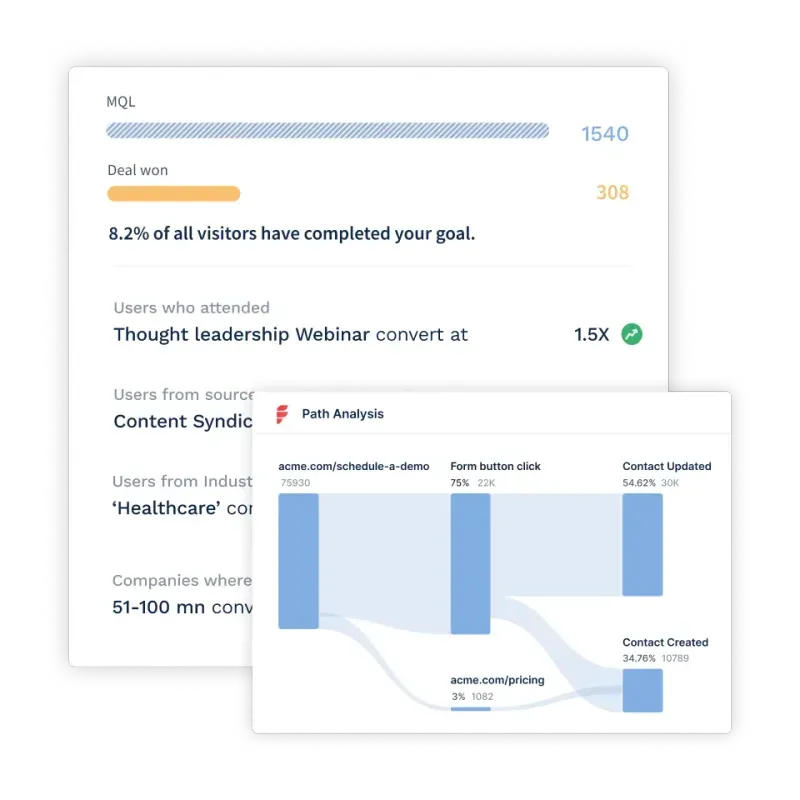
2. Offers a quick overview of data without wasting time and resources
A CMO dashboard lets you save hours of work and wasted resources on collecting and processing raw data from scratch.
CMO dashboards extract and present an accurate overview of essential data from platforms or sources such as LinkedIn, Facebook, YouTube, articles, Google Ads, and more.
For example, let’s say you’re calculating the number of sessions on your website that come through various channels. A CMO dashboard will gather the data from all the channels, creating an easy visual for you to see which has driven the most sessions.
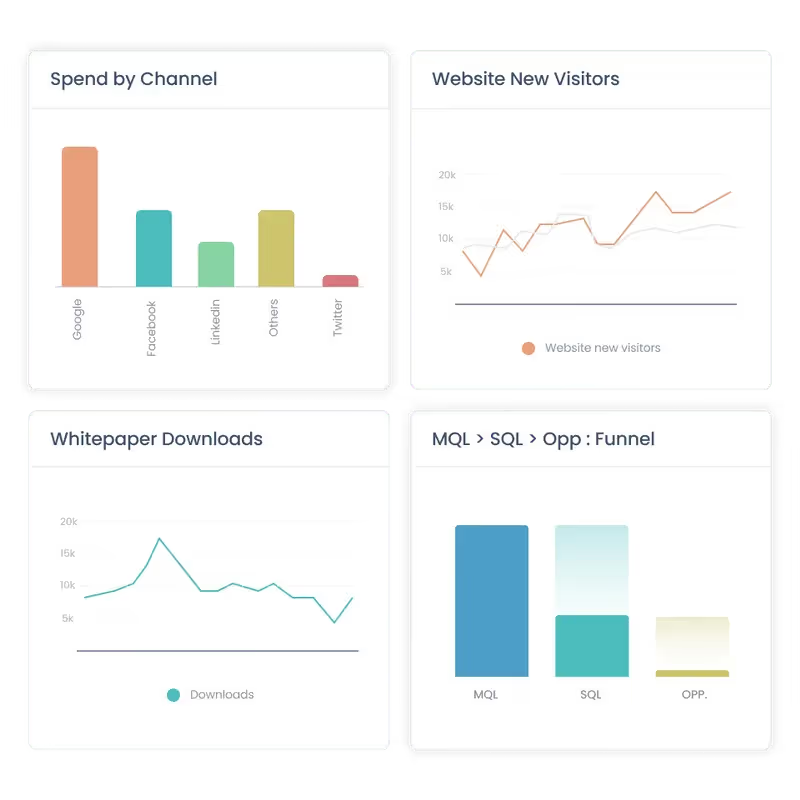
3. Helps identify trends and patterns
With all the data condensed onto one dashboard, CMOs and their teams can collectively take note of repetitive patterns in their target audience. This helps them further understand which type of campaigns work well on what channel and when leading to the ability to adapt campaign resources on the go.
For example, the company publishes a blog on the website every Tuesday. But they also post a video on LinkedIn on the same day. Over time, a CMO dashboard can display which content formats perform better on Tuesdays, helping the team double down their focus on that channel alone.
Key considerations when building a CMO Dashboard
An effective CMO dashboard is the central hub for monitoring marketing performance, aligning teams, and driving data-backed decisions. When designed thoughtfully, it becomes an invaluable strategic asset.
1. Intuitive and action-oriented design
A CMO dashboard is defined by its ease of use and ability to drive decisions. A cluttered, text-heavy layout overwhelms users with data but does not provide enough context to make decisions.
In contrast, a clean, visual interface tells a straightforward performance story that connects insights to actions and helps make data-backed decisions. Here are a few considerations for an insightful dashboard.
Prioritize key metrics
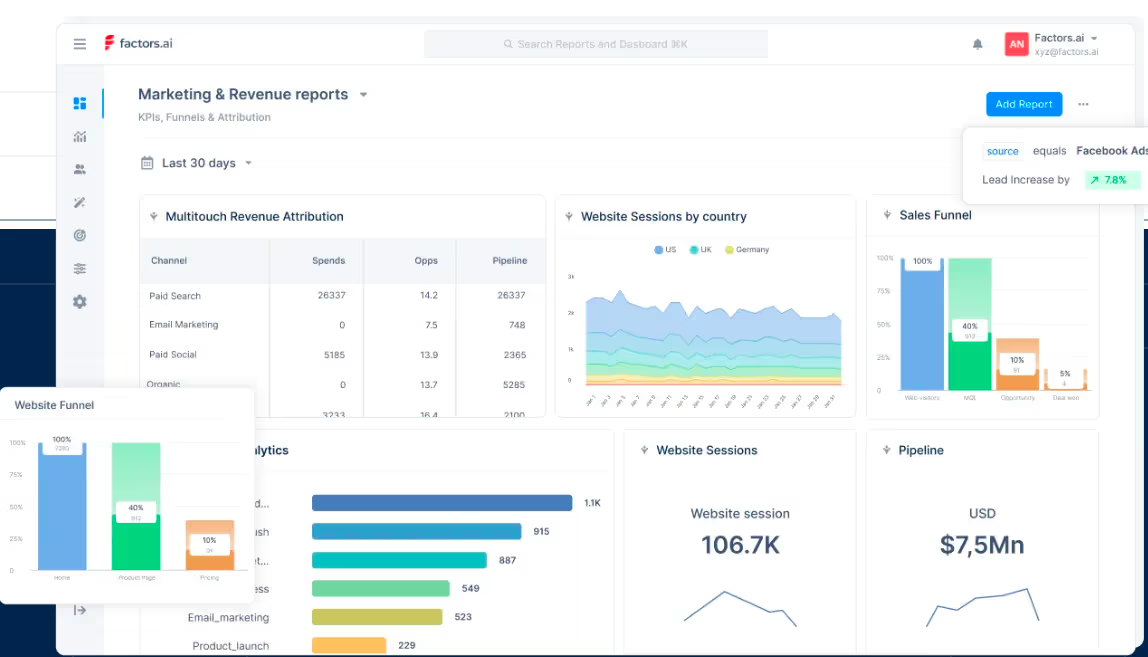
Prioritize the most critical metrics and add impactful visualizations like charts, graphs, gauges, and indicators to showcase them. For instance, use:
- Line charts to display trends over time for metrics like web traffic, conversions, etc.
- Comparison charts or pie charts to show channel effectiveness, campaign ROI, and more
- Funnel visualization to showcase drop-offs across the customer journey
- Alerts and gauges to highlight metrics nearing goals or thresholds
Optimize Information Absorption
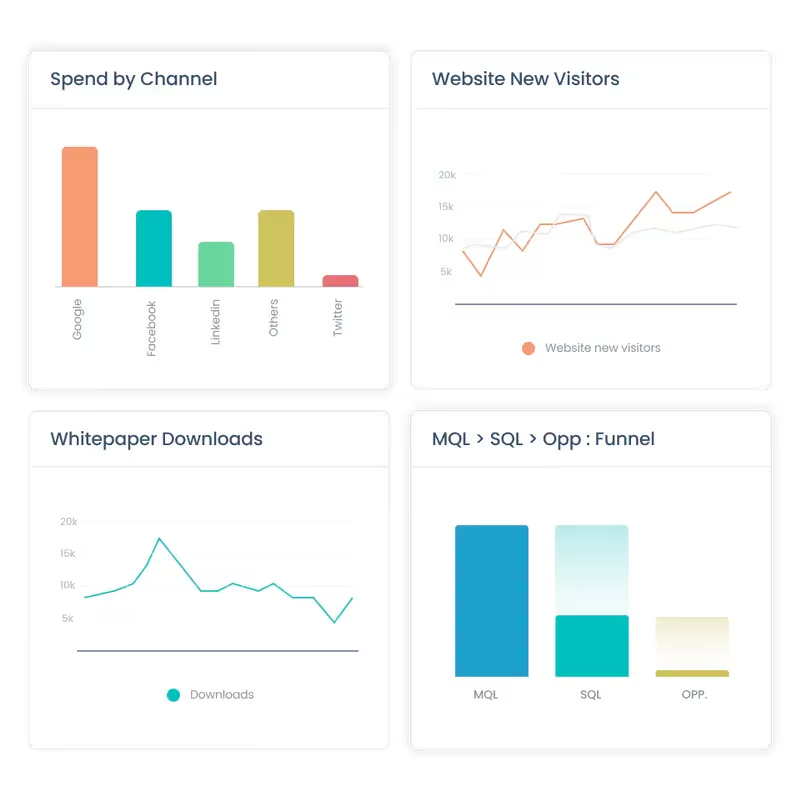
Use color coding, alerts, and trends to highlight priority areas at a glance. Make sure that your dashboards have ample white space for better data absorption.
Also, include explanatory captions and annotations to provide essential context.
Offer Intuitive Interactions
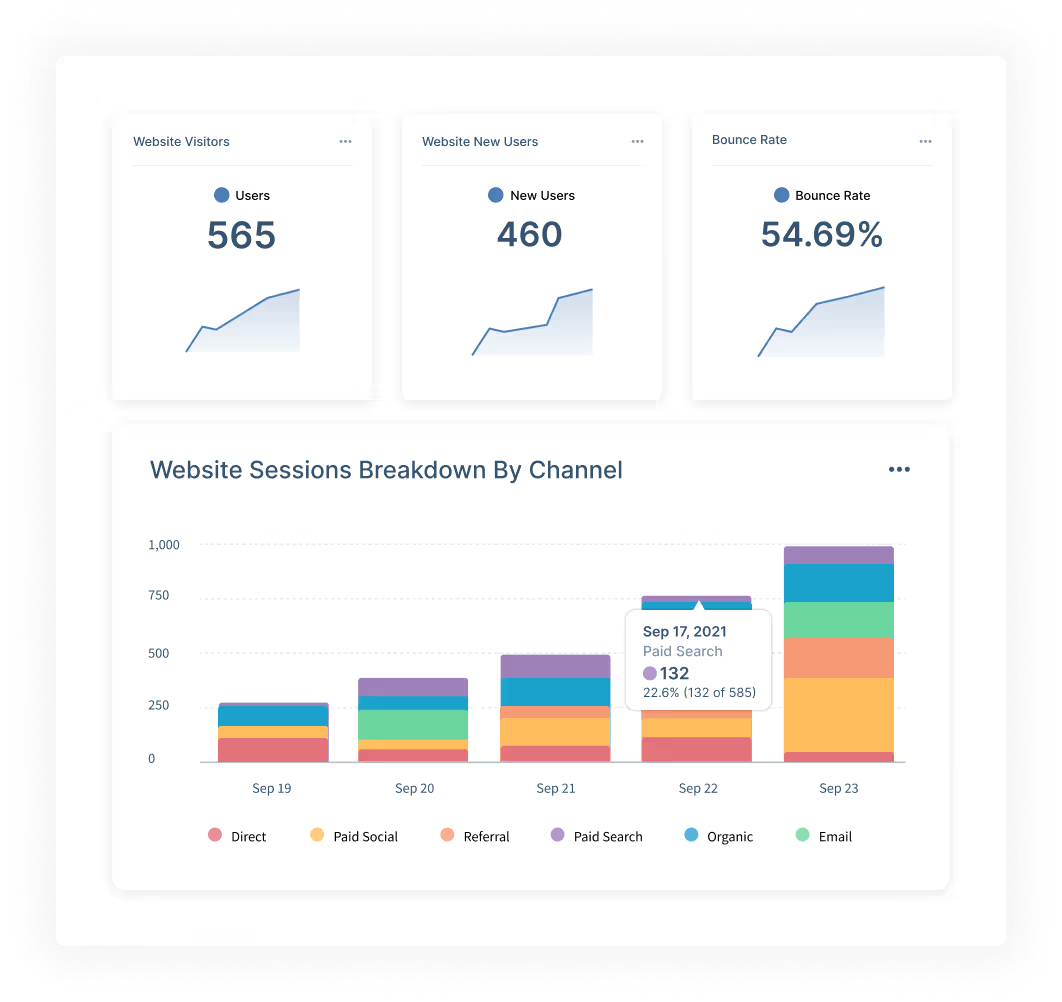
Offer intuitive interactions like drill-downs, filtering, and segmenting to customize views on demand. For instance, help users:
- Filter data by categories, campaigns, regions, or date ranges
- Drill down from aggregate metrics to detailed data breakdowns
- Isolate underperforming categories and campaigns
Such flexibility allows slicing and dicing data along different dimensions for deeper analysis.
Streamline Navigation
Create tabs or dropdowns to switch between views, campaigns, time frames, and other dimensions. Optimize compatibility across devices so users can access the dashboard anywhere conveniently.
Most importantly, align terminologies and visualizations to thought processes familiar to users through day-to-day work. Simplicity and intuitiveness accelerate adoption.
2. Unified Data Foundation Across Teams

Marketing cannot drive impact alone. Close alignment across teams provides comprehensive visibility into the end-to-end customer journey.
Break Departmental Silos
Integrate your CMO dashboard tightly with essential systems like CRM, sales analytics, web analytics, finance systems, etc. Automatically sync campaign data, lead status changes, deal progress, and other cross-functional data flows.
For instance, pull web visitor profiles from analytics platforms to enrich lead records. Or, pass lead quality assessment and scoring metrics from marketing to sales for better follow-ups.
Shared Visibility Through Attribution
Compare the performance of marketing-generated vs. sales-generated pipelines on metrics like lead quality, sales cycle times, win rates, and deal sizes.
Conduct multi-touch attribution to understand marketing's influence at each buying stage. Such unified visibility bridges departmental silos with shared goals and metrics, steering coordinated priorities across teams.
3. Flexibility to Highlight Strategic Focus Areas
While cross-functional data consolidation provides tremendous value, a one-size-fits-all dashboard rarely meets specialized business needs fully. You need the dashboard to be customizable and dynamic.
Customizable Templates
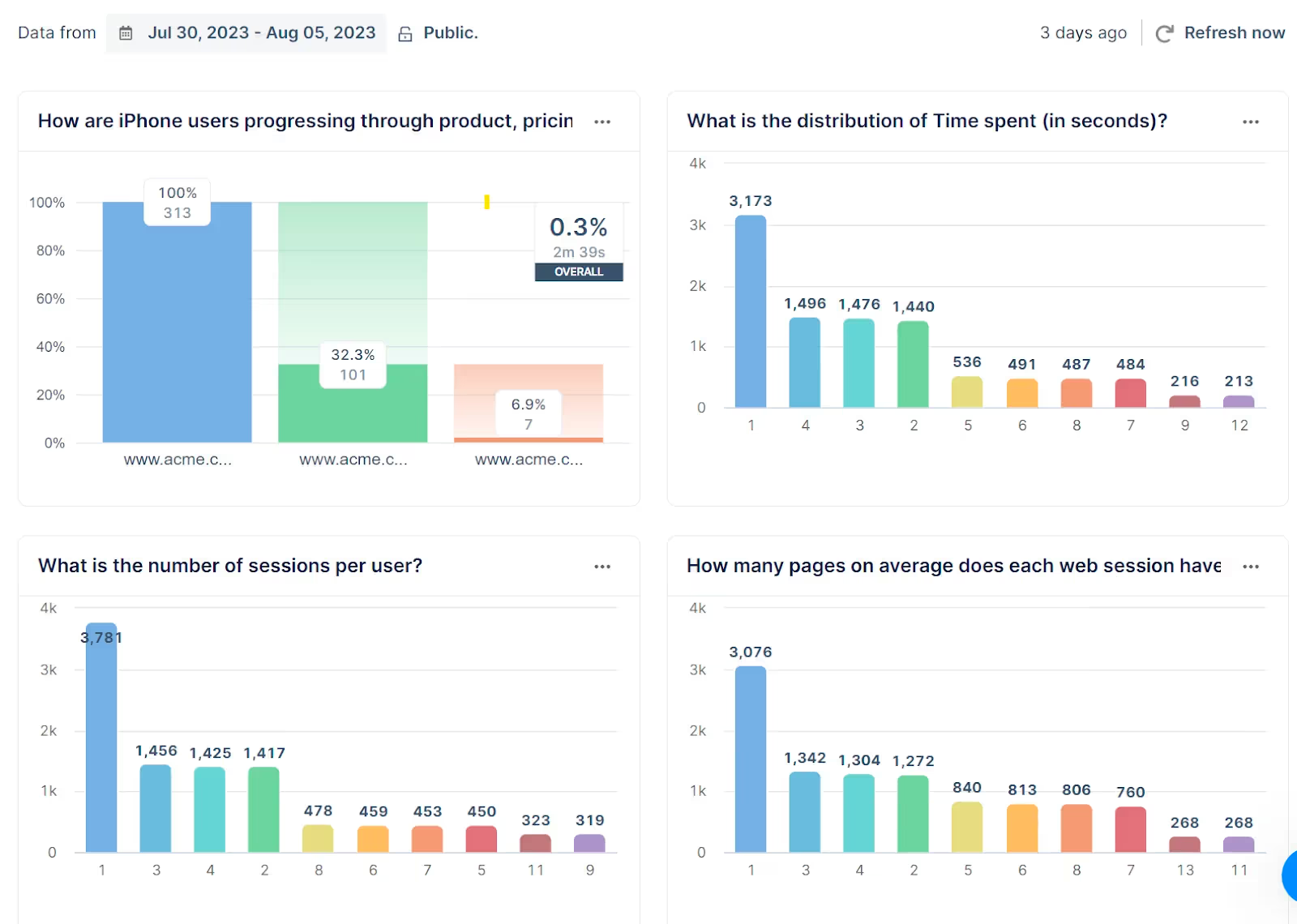
Empower users to highlight metrics aligned to their goals—broad awareness or targeted account-based sales—without relying on IT.
Provide pre-built templates for different personas and use cases that showcase industry-specific benchmarks more relevant to their context.
Dynamic Filtering and Segmentation
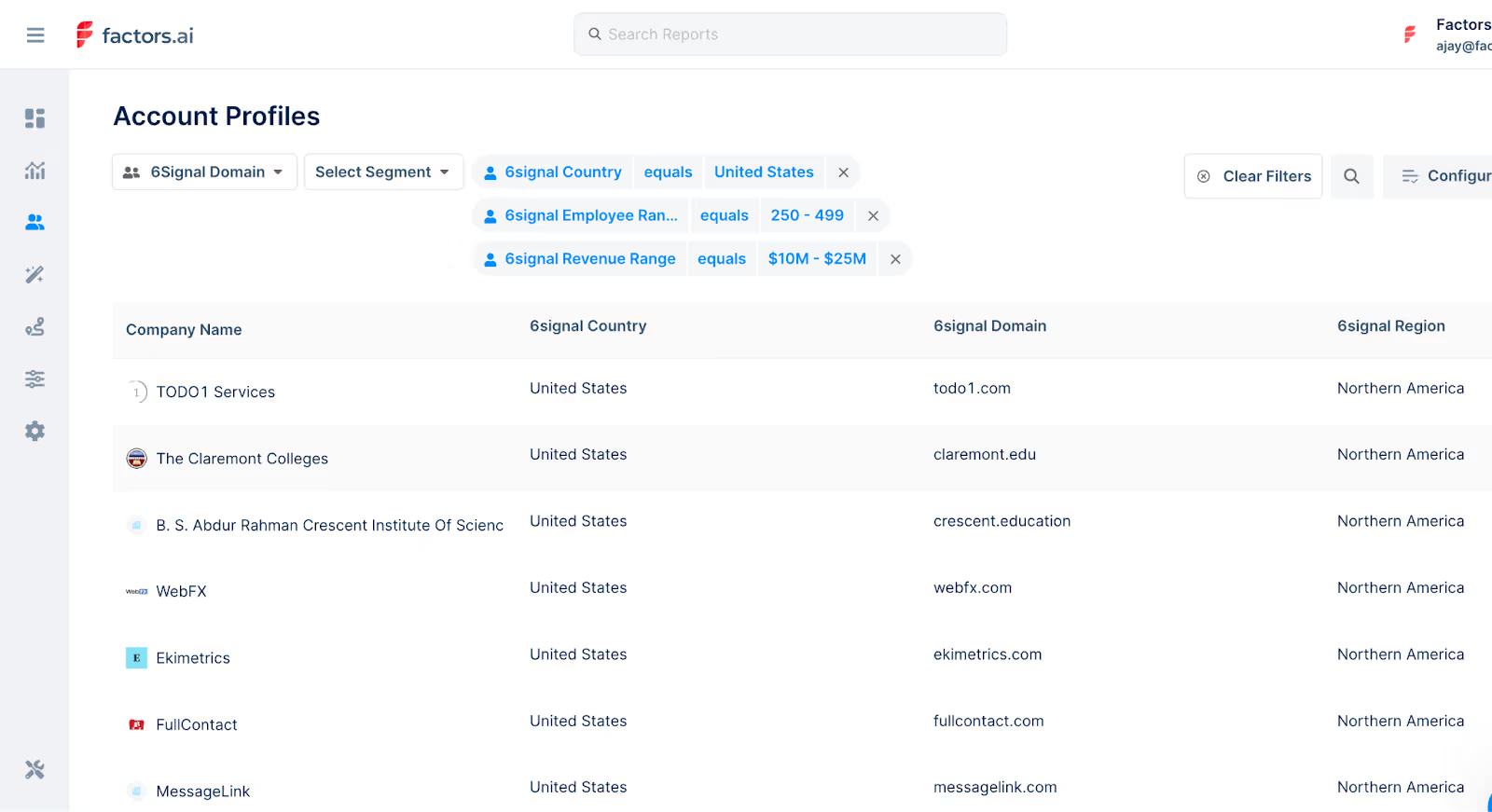
Offer easy-to-use customization options such as an intuitive template builder interface. Let marketers filter data views dynamically by parameters like region, customer persona, product line, etc.
Such flexibility allows teams to analyze performance through different lenses—whether for the leadership team or campaign managers. As business objectives evolve, custom-tailored dashboards stay focused on what matters most.
4. Ongoing Optimization and Iteration
No dashboard gets designed perfectly right from the beginning. As marketing campaigns and strategies adapt in response to market dynamics, your dashboards also continuously realign to maintain relevance.
User Testing and Feedback Analysis
Monitor usage patterns and user feedback to identify navigation, metric, or visualization enhancements: track clicks, hovers, and other interactions to uncover usability issues. Conduct user surveys and interviews to gather feedback.
Maintain Flexibility
Maintain flexibility for adding new datasets from emerging sources and channels. Continually experiment, test, and optimize to fulfill ever-changing information needs most effectively.
Through an intuitive and action-oriented design backed by an integrated, flexible data foundation, the CMO dashboard becomes a powerful nerve center driving shared visibility, coordinated execution, and data-informed decisions across the business.
CMO Dashboard KPIs and Metrics
A CMO dashboard can include tons of KPIs and metrics depending on what you’re trying to track. However, below are the ones that are of topmost priority:
1. Top-of-the-funnel metrics such as engagement, traffic, leads
Top-of-the-funnel metrics are brand awareness metrics like the engagement rate, traffic, and leads generated. Most SaaS marketing executives track these to attract the target audience and turn them into long-term subscribers.
1. Engagement rates are metrics used to measure and track the active involvement of your target audience for the content you produce. The engagement rate formula is:
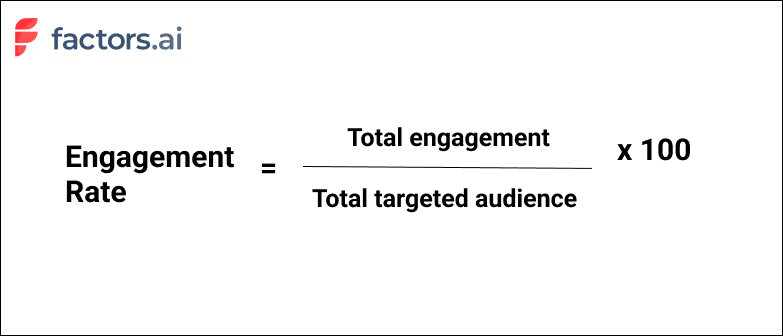
2. Traffic for SaaS companies is the volume or the total number of visitors their website gets over a certain time period.
3. Leads generated is a mandatory sales KPI every SaaS company must track. Measuring leads lets you uncover issues and nurture prospects further.
Why do these metrics matter?
Top-of-the-funnel metrics help measure the overall exposure of the target audience to your marketing efforts. Tracking and measuring them gives insight into what can help minimize roadblocks that stop prospects from signing up.
2. Conversion rates and efficiency
1. Conversion rates: measure the number of targeted users who converted from unknown prospects to engaged contacts. The higher the conversion rate, the more impact your marketing strategies have. The formula to calculate the conversion rate is:
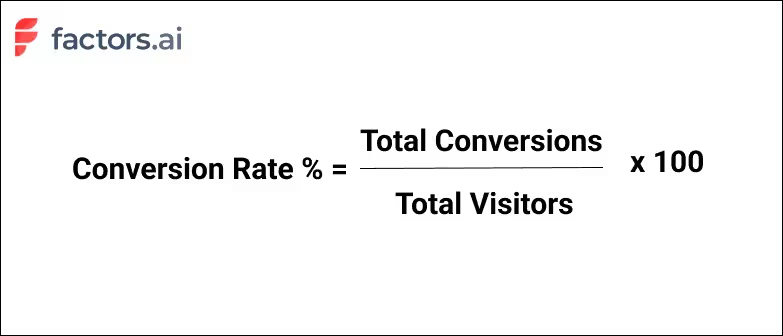
2. Efficiency: In marketing, the ROI measures the overall performance of your marketing efforts, and conversion rates directly indicate the performance. That means increasing conversion rates while reducing acquisition costs promises a better ROI and shows better strategy efficiency. The formula to calculate marketing efficiency is:
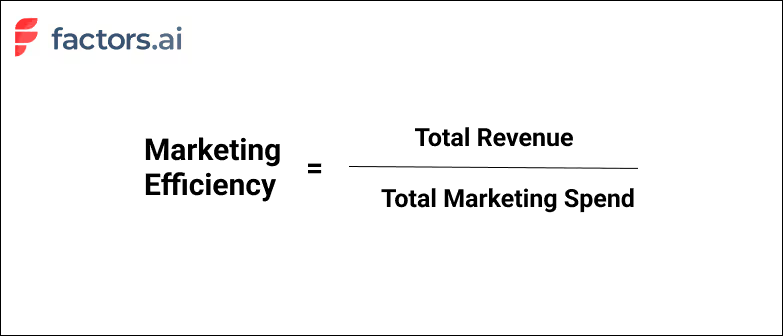
Why do these metrics matter?
Conversion rates and efficiency directly reflect how well your SaaS marketing activities are executed and determine the overall effectiveness of your business campaigns.
3. Cost of acquisition by channel
It’s best to track certain KPIs by marketing channels, such as social media, emails, ads, organic search, etc. Calculating the cost of customer acquisition (CAC) for each channel is one such KPI that indicates the marketing expenses spent on obtaining customers.The formula to calculate CAC by channel is:
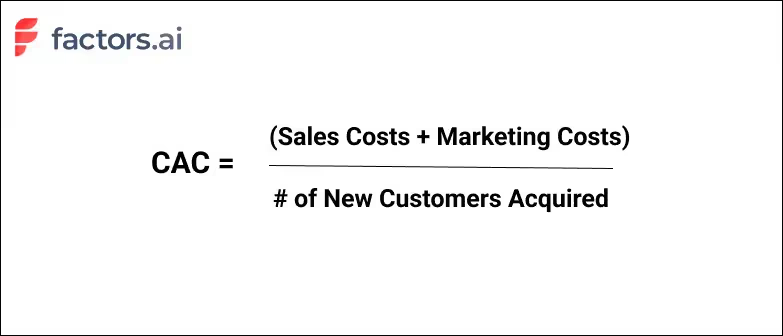
Why does this metric matter?
Measuring CAC lets you decide whether or not to pursue marketing for a particular channel and demonstrates high-performing marketing channels having low CAC.
4. Retention and churn rates
Customer retention and churn rates are opposites that indicate the number of customers retained or lost over a time period. The formula to calculate churn rate is:
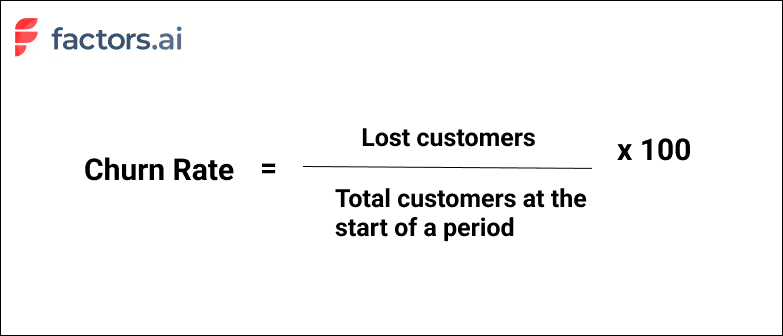
Why are these metrics important?
Customer churn and retention rates are one of the most important metrics for SaaS CMOs. Measuring churn rate can help shed light on why subscribers are refusing to renew your service, and based on high or low retention rates, you can decide whether to pursue the same strategies or refresh them.
5. Customer lifetime value
Customer lifetime value, or CLV, indicates the average pay throughout a customer’s relationship with your company. It is a critical SaaS KPI to showcase revenue as it conveys a customer’s worth on average. The formula to calculate CLV is:

Why does this metric matter?
CLV is a critical SaaS business viability measure. It is essential for understanding the business value each customer brings and your SaaS company’s long-term potential.
6. Revenue and pipeline velocity by channel source
1. Revenue by channel source tracked by CMOs indicates how well their ads, campaigns, and other marketing efforts perform based on their source. Additionally, it tells you the aggregate revenue earned from successful conversions from each outlet.
2. Pipeline velocity by channel source is a key KPI indicating the speed at which leads move through your sales pipeline for each channel source.
Why do these metrics matter?
A high pipeline velocity means smoother onboarding processes and better conversions. So tracking this and revenue by channel source over various periods lets you improve conversions from each source.
7. Revenue Growth Percentage
Revenue growth percentage indicates how rapidly total company revenue increases over a set time, typically month-over-month or year-over-year. It shows the overall momentum and health of the business.
The formula to calculate revenue growth is straightforward—take the revenue difference between the current and past periods and divide that by the one-time period revenue.
For example, for year over year revenue growth, use the formula:
((Current Yearly Revenue - Last Year's Yearly Revenue) / Last Year's Yearly Revenue) x 100.
Why does this metric matter?
Monitoring rapid or declining growth % signals how well marketing and sales efforts are faring and hitting targets. When coupled with cost metrics, it also showcases profitability trends. Understanding growth by revenue streams also enables executives to double down on the highest traction channels.
8. Customer Lifetime Value
Customer lifetime value totals the likely earnings a business can generate from customers throughout their tenure. In essence, it conveys an average customer's worth.
The formula factors average order size, purchase frequency in a given period, and the average lifespan.
For instance, CLV may be calculated as: CLV = Average Order Value x Purchase Frequency Per Year x Average Lifespan in Years.
Why does this metric matter?
Tracking CLV over annual cohorts helps spotlight content, features, or channel innovations that make customers stickier. Comparing CLV vs acquisition cost also determines the breakeven period to recover expenses.
9. Cost Per Lead
Cost per lead signifies the average expenditure to generate a qualified marketing lead. It is calculated by dividing total lead gen marketing spend by the number of leads captured.
CPL can be calculated as: Total marketing dollars spent / Number of leads
If you spent $1000 to get 10 customers, that’s 1000/10 = $100 — Your CPL is $100.
Why does this metric matter?
Monitoring CPL trends determines the influence of brand equity on the sales funnel—a strong brand lowers CPL over time.
Comparing CPL by channel also helps optimize spending by identifying the lowest-cost customer acquisition sources. Analyzing CPL alongside customer lifetime value further ascertains profitable activities.
10. Brand Search Volume

Brand search volume measures monthly search queries for your brand name and keywords. Sudden surges or declines show changing consumer interest.
Why does this metric matter?
Tracks brand visibility gains/losses to correlate awareness-building campaigns and events. Guides keyword targeting and content strategies.
Creating Effective CMO Dashboards in Factors AI
Over the course of this article, we’ve covered what a CMO dashboard is, what its benefits are, and a few common metrics for CMOs to track. But constructing a comprehensive CMO dashboard is easier said than done — unless of course, you leverage a tailor-made dashboarding tool like Factors.
Factors unifies and reports data across complex buyer journeys involving multiple stakeholders, touchpoints, and channels under one roof. What does this mean for you? No more individual tools to analyze campaign performance, website engagement, and pipeline/revenue related metrics.
It’s simply all the metrics you care about as CMO in one, intuitive, customizable dashboard. Here are a few nifty features loved by CMOs:
- Ad hoc filters and breakdowns: Slice and dice metrics and KPIs with a wide range of filters and breakdowns to answer questions like: “How does conversion rate vary between companies with at least 200 employees and smaller teams of less than 50?” or “What’s the difference in sales velocity between leads from paid search and organic social?”
- Automated AI-fueled insights: It’s one thing to have your data in one place — but how can CMOs make sense of the numbers? Factors offers automated insights into what’s helping and hurting a specific conversion goal. What’s driving demo form submissions? Our Explain engine may suggest Linkedin campaigns and the pricing page have a positive influence while Display ads and email outreach is limiting performance. This helps the larger team improve resource allocation and drive ROI.
- Custom funnels, KPIs, and properties: Every business has different requirements. This is no different when it comes to reporting and dashboarding needs. Factors supports limitless customizations to KPIs and properties so CMO dashboards can be tailor-made to the what matters most to you.
A SaaS CMO dashboard is a centralized tool that visualizes key marketing metrics, such as conversions, traffic, customer acquisition cost, churn, and pipeline velocity, across channels. It enables CMOs to make data-driven decisions, optimize strategies, and align teams effectively.
Essential Features of a SaaS CMO Dashboard:
- Intuitive Design: Easy-to-use interface that helps users quickly understand performance.
- Integrated Data Sources: Combines data from multiple channels and systems for a comprehensive view.
- Real-time Insights: Provides up-to-the-minute information to make fast, informed decisions.
Enhancing with Factors:
- Automated Data Consolidation: Factors.ai streamlines data collection and reporting.
- Actionable Analytics: Provides insights that drive optimization and increase ROI.
- Improved Operational Efficiency: Reduces manual tasks, allowing marketing teams to focus on strategy and execution.
Curious to see Factors in action? Schedule a personalized demo here!

ICP vs. Buyer Persona? What is the Difference
Many teams invest in different marketing campaigns but see little conversion or slow sales cycles. Often, the issue is not knowing who to target or how to engage them, leading to wasted budgets and missed revenue opportunities.
The solution? Utilize two key tools: the Ideal Customer Profile and the Buyer Persona. ICP marketing focuses on companies that benefit most from your solution, while buyer personas guide you in reaching the decision-makers within those companies. Together, they make your marketing strategic and effective, boosting ROI and growth.
Read: What is Buyer Intent Data for ABM
In this blog, you'll explore the differences between ICPs and buyer personas, their impact on B2B marketing ROI, and how to leverage both for optimal results. Let's address your targeting challenges once and for all.
TL;DR
- ICP marketing targets companies that align best with your B2B solution, optimizing resource allocation and lead quality.
- Buyer personas focus on decision-makers within those companies, enhancing personalization and engagement.
- ICPs prioritize valuable accounts, streamline account-based marketing (ABM), and align sales and marketing for improved conversion rates.
- Buyer personas enhance content personalization, nurture campaigns, and sales interactions by addressing specific roles, challenges, and motivations.
- Relying solely on one approach can limit ROI. Combining ICP and buyer persona strategies ensures precise targeting and higher returns.
- Regularly update your ICP and buyer personas to align with market changes, customer feedback, and business objectives.
- Avoid common pitfalls: base profiles on data, keep them current, and leverage insights for informed decisions.
- For B2B marketers, integrating ICP marketing and buyer personas leads to higher ROI, shorter sales cycles, and stronger customer relationships.
- Discover how to build, use, and enhance both tools for B2B growth below.
What is ICP Marketing in B2B?
An Ideal Customer Profile (ICP) defines the type of company that gains the most from your product and delivers the most value in return. In B2B marketing, it’s a core tool for focusing on high-potential accounts and using resources efficiently.
A strong ICP includes firmographics (industry, size, location), technographics (tech stack, digital maturity), and behavioral traits (buying process, engagement). It’s built by analyzing top customers and identifying shared traits through CRM data, sales insights, and customer feedback.
What is Buyer Persona in B2B?
Buyer personas are detailed profiles of the decision-makers within your target accounts. While an ICP identifies the ideal companies to target, buyer personas focus on the individuals, like a CMO or IT Director, who influence or make purchasing decisions. These profiles include job roles, goals, pain points, and buying behavior.
Creating accurate personas involves analyzing customer conversations, sales data, and digital engagement to understand motivations and preferences. With strong buyer personas, you can craft personalized messaging and campaigns that speak directly to each role, improving engagement, speeding up sales cycles, and boosting conversion, much like our Intent Capture tool.
Also, read the five stages of a customer journey.
ICP vs. Buyer Persona: Core Differences
Here’s the quick comparison between ICP and Buyer Persona:

ICP Marketing vs. Buyer Persona: Which Delivers Better ROI?
To determine which approach offers better ROI in B2B, examine how each affects your sales pipeline and revenue.
1. ICP Marketing: Bigger Deals, Better Fit
ICP marketing drives ROI by focusing your efforts on companies most likely to convert and deliver long-term value. By targeting firms with the right industry, size, budget, and tech stack, you avoid low-fit leads, close larger deals, and use your sales team's time more effectively.
2. Buyer Personas: Higher Engagement, Faster Wins
Persona-driven strategies boost ROI by personalizing your message to key decision-makers. When you understand their pain points, goals, and preferences, your campaigns resonate more deeply, leading to higher engagement, quicker sales cycles, and increased win rates within your target accounts.
3. The ROI Sweet Spot: Use Both
Relying on only one strategy limits your impact. ICPs without personas can feel too generic, while personas without ICPs may waste resources on the wrong companies. The highest ROI comes when you combine both: target the right organizations with ICPs, then win over the right people with buyer personas.
When to Prioritize ICP or Buyer Persona in Your B2B Strategy?
Decide whether to focus on ICP or buyer persona based on your business goals. If you aim for account-based marketing, lead qualification, or expanding outreach, start with a clear ICP. This helps your team target companies with the best potential for value and strong relationships, improving resource use and conversion rates.
If you want to boost engagement, personalize campaigns, or enhance sales support, focus on buyer personas. Understanding the motivations, challenges, and decisions of key people in your ICP companies helps you create messages that connect, leading to better responses and quicker sales.
For the best outcome, combine both methods: use ICPs to choose the right companies, then apply buyer personas to reach the right people within those companies. This approach ensures you connect with the right accounts and speak directly to decision-makers, maximizing your B2B marketing success, similar to how our Workflow Automations can streamline your processes.
How to Integrate ICP and Buyer Personas for Maximum ROI?
1. Start with the Right Targets
Begin by clearly defining your Ideal Customer Profile, companies that are most likely to benefit from your solution. Use firmographics, technographics, and business alignment to pinpoint your best-fit accounts and prioritize them for outreach.
2. Add Depth with Decision-Maker Insights
Next, bring your strategy to life with buyer personas. Identify key decision-makers within your ICP accounts, like Marketing VPs or IT Directors, and map out their goals, pain points, and preferences. This helps you tailor campaigns that speak directly to their needs.
3. Align, Execute, and Evolve
Use the ICP to guide account targeting and resource focus, while personas power your messaging. Personalize content, ads, and sales conversations to engage each stakeholder effectively. Keep both profiles updated as your market shifts to stay relevant and drive long-term ROI, just like our Funnel Conversion Optimization strategies ensure consistent pipeline performance.
Wrapping Up: Integrating ICP and Buyer Persona
Defining and utilizing both your Ideal Customer Profile and buyer personas is crucial for maximizing return on investment in B2B marketing. ICP marketing helps you focus on organizations that will benefit most from your solution, optimizing resource use and increasing success rates. Buyer personas help your team create messages and campaigns that connect with real decision-makers in those companies, boosting engagement and accelerating sales.
Successful B2B strategies integrate both ICP and buyer personas. The ICP guides targeting, while buyer personas personalize each interaction. Regular updates based on real data and feedback keep your approach effective. Avoid common mistakes like outdated profiles or ignoring negative personas to enhance your marketing. Mastering both ICP marketing and buyer persona development builds a strong foundation for growth, better customer relationships, and measurable marketing success.
.avif)
How to Implement Predictive Marketing Analytics?
B2B marketing can be complex, with many moving parts and uncertain outcomes. Predictive marketing analytics helps by using past data to provide clear insights, making it easier to plan and improve your marketing efforts.
This guide will show you how to implement predictive marketing analytics in a step-by-step process to understand your customers better, allocate resources wisely, and grow your business.
TL;DR
- Predictive marketing analytics enables B2B marketers to forecast customer actions, enhance campaigns, and improve ROI using historical and current data.
- Key predictive models include classification, clustering, regression, propensity, and time series, aiding in lead scoring, segmentation, and churn prediction.
- Successful implementation involves setting clear goals, gathering and cleaning data, selecting appropriate models, and applying insights to marketing tasks.
- B2B use cases encompass lead scoring, customer lifetime value prediction, churn reduction, campaign optimization, and upselling/cross-selling.
- To ensure success, address challenges such as data quality, integration, and skill gaps.
Why Predictive Marketing Analytics is Important?
For B2B marketers, predictive marketing analytics is a game-changer. Here’s how:
- Maximizes Lead Value: In complex B2B sales cycles, predictive analytics helps prioritize high-value leads, ensuring your team focuses on the most promising opportunities.
- Eliminates Guesswork: Moves your strategy from intuition-based to data-driven, reducing wasted efforts on low-quality leads.
- Improves Targeting: Identifies which accounts are most likely to convert, the best times to engage, and which messages will resonate.
- Boosts Conversion Rates: Helps optimize campaigns and outreach, leading to more efficient pipelines and higher win rates.
- Accelerates Revenue Growth: Enables marketing and sales teams to make faster, smarter decisions that directly impact the bottom line.
- Supports Strategic Planning: Provides actionable insights for campaign planning, resource allocation, and long-term growth strategies.
Also, read our blog on strategies to improve B2B pipeline acceleration.
Core Predictive Models for B2B Marketing
Predictive marketing analytics employs several key models to aid B2B marketers in making informed decisions:
1. Classification Models
These models categorize data into defined outcomes. In B2B marketing, classification models can predict whether a lead is likely to convert, become a high-value customer, or churn.
- Example Use Case: Score leads as ‘high,’ ‘medium,’ or ‘low’ priority based on historical conversion data.
2. Clustering Models
Clustering models group leads or accounts based on shared characteristics or behaviors, without predefined categories. These segments often reveal hidden patterns in your data.
- Example Use Case: Identify customer segments based on product usage, engagement level, or firmographic data to run more targeted campaigns.
Also, read our guide on B2B Account Scoring.
3. Regression Models
Regression helps estimate the relationship between variables. Marketers can use it to forecast outcomes like future revenue based on changes in marketing spend, email frequency, or campaign duration.
- Example Use Case: Predict how a 10% increase in ad spend might impact lead volume or conversion rates.
4. Propensity Models
These models calculate the likelihood that a prospect will take a particular action, such as clicking an email, requesting a demo, or renewing a subscription.
- Example Use Case: Predict which existing accounts are most likely to respond to a cross-sell or upsell offer.
5. Time Series Models
Time series analysis helps marketers understand and forecast data that varies over time, such as web traffic, campaign engagement, or seasonal demand.
- Example Use Case: Forecast quarterly lead volume or identify optimal times to launch a campaign.
How to Apply the Right Model for Impact?
Choosing the appropriate predictive model depends on the business question you're trying to answer. Whether it’s prioritizing accounts, forecasting demand, or improving personalization, applying the right model allows B2B marketers to:
- Focus on high-potential opportunities.
- Tailor messaging to segmented needs.
- Allocate budget and resources effectively.
For real-world examples of how these models power outreach strategies, visit our Cold Outbound for GTM Efforts page.
How to Implement Predictive Marketing Analytics?
Implementing predictive marketing analytics in your B2B strategy involves several key steps:
1. Set Clear Business Objectives
Before building models, define what specific outcome you want to predict. This could be:
- Lead conversion likelihood.
- Customer churn risk.
- Likelihood of upsell or renewal.
- Optimal timing for campaign engagement.
Clear goals help shape the data you collect and the type of model you choose. It also ensures alignment between marketing, sales, and leadership teams.
2. Data Collection and Integration
Gather data from all relevant sources such as:
- CRM systems (e.g., Salesforce, HubSpot)
- Marketing automation tools.
- Website analytics platforms.
- Customer support and engagement data.
Make sure these sources are integrated and accessible from a central location. For smoother data consolidation, explore the tools featured on our Integrations page.
3. Data Cleaning and Preparation
Data quality is critical for model accuracy. Clean your data by:
- Removing duplicates and errors.
- Handling missing or inconsistent values.
- Normalizing and formatting data for compatibility.
This step also includes feature engineering, such as creating new variables from raw data to improve model performance.
4. Model Selection and Building
Choose the most appropriate model based on your goal:
- Classification for predicting binary outcomes (e.g., will convert or not)
- Regression for forecasting numerical outcomes (e.g., deal value)
- Clustering for segmenting customers.
- Propensity modeling for behavior prediction.
You can start with off-the-shelf models or build custom models using platforms like Python, R, or AutoML tools.
5. Model Training and Validation
Use historical data to train your model. Then, validate it by:
- Splitting your data into training and testing sets.
- Measuring accuracy, precision, recall, or other relevant metrics.
- Performing cross-validation to check robustness.
This ensures the model generalizes well and isn’t just overfitting to past data.
6. Deployment and Workflow Integration
Deploy your predictive model and integrate its insights into your daily marketing operations:
- Add lead scores to your CRM.
- Trigger automated campaigns based on behavior predictions.
- Alert sales teams about accounts at risk of churn.
The key is to make predictive insights actionable within existing tools and workflows.
7. Monitoring, Evaluation, and Continuous Improvement
Predictive models are not “set-it-and-forget-it.” Continuously:
- Track model performance over time.
- Incorporate new data and retrain as needed.
- Adjust based on changes in customer behavior or market trends.
Establish feedback loops with marketing and sales teams to refine the models and improve relevance.
This structured approach ensures predictive marketing analytics are effective, measurable, and aligned with business objectives.
Key Use Cases of Predictive Marketing Analytics in B2B
Predictive marketing analytics offers numerous applications for B2B marketers:
1. Lead Scoring and Segmentation
Use predictive models to identify which leads are most likely to convert based on historical behavior, engagement patterns, and firmographic data.
- Helps sales teams prioritize high-potential leads.
- Enables better-targeted nurture campaigns.
- Reduces time spent on low-quality prospects.
2. Customer Lifetime Value (CLV) Prediction
Estimate the long-term value of individual accounts to guide strategic decision-making.
- Focus resources on accounts that promise the highest return.
- Personalize long-term engagement strategies.
- Inform account-based marketing (ABM) prioritization.
3. Churn Prediction and Retention Strategies
Identify warning signs of potential churn based on product usage, engagement drop-offs, or support issues.
- Proactively reach out to at-risk clients.
- Launch personalized retention campaigns.
- Reduce customer attrition and stabilize recurring revenue.
4. Campaign Optimization and Budget Allocation
Predict which messaging, channels, or timing combinations will drive the best outcomes.
- Allocate budgets to high-performing campaigns.
- Adjust spend dynamically based on predictive insights.
- Improve overall ROI by minimizing waste.
5. Upselling and Cross-Selling Opportunities
Analyze customer behavior and transaction history to detect readiness for additional products or services.
- Suggest relevant offerings based on past actions.
- Tailor sales conversations with data-backed recommendations.
- Increase average deal size and deepen customer relationships.
These use cases provide a data-driven advantage, enhancing efficiency, conversion rates, and customer satisfaction.
Common Challenges in Implementing Predictive Marketing Analytics
While predictive marketing analytics offers significant benefits, B2B organizations often encounter roadblocks during implementation. Understanding these challenges is key to overcoming them and ensuring long-term success.
1. Poor Data Quality
Predictive models are only as good as the data they’re built on.
- Incomplete, outdated, or inconsistent data can lead to inaccurate predictions.
- Disconnected data sources (e.g., separate CRM and marketing platforms) make it difficult to get a unified customer view.
Solution: Prioritize data hygiene by cleaning, standardizing, and unifying datasets before modeling begins. Automate this process where possible.
2. Integration Complexities
Merging predictive analytics tools with your existing stack can be technically challenging.
- Legacy systems and siloed platforms may require custom APIs or middleware.
- Inconsistent data formats can delay deployment.
Solution: Choose tools with strong integration support and open architecture. Engage IT early to ensure alignment.
3. Lack of In-House Expertise
Many marketing teams are not equipped with the data science skills needed to develop and maintain predictive models.
- Limited understanding of machine learning may result in misinterpreting model outputs or relying on default settings.
Solution: Provide regular training or hire specialists. Alternatively, work with external consultants or platforms that offer managed predictive services.
4. Resistance to Change
Adopting predictive analytics often requires a shift in mindset.
- Teams may hesitate to move away from intuition-based strategies.
- Concerns about job displacement or workflow disruptions can lead to pushback.
Solution: Start with small, high-impact use cases to demonstrate value. Involve stakeholders from the start to build trust and buy-in.
5. Model Maintenance and Relevance
Predictive models require ongoing tuning and updates.
- Market dynamics, buyer behavior, and internal business goals can change quickly.
- Static models degrade over time, reducing their effectiveness.
Solution: Establish a regular schedule for model evaluation and retraining. Incorporate real-time data feeds where feasible.
6. Privacy and Compliance Risks
Handling sensitive B2B customer data introduces legal and ethical challenges.
- Non-compliance with regulations like GDPR or CCPA can result in penalties.
Solution: Ensure your data handling practices comply with industry regulations. Collaborate with legal teams during planning and execution.
By proactively addressing these hurdles, B2B organizations can unlock the full potential of predictive marketing analytics and build smarter, data-driven strategies.
Wrapping Up: How Predictive Marketing Analytics Drives Business Growth?
Incorporating predictive marketing analytics into your B2B strategy is essential for maintaining competitiveness and achieving growth. Following a structured plan can transform data into insights that enhance lead scoring, campaign targeting, and customer value.
Begin with clear objectives, ensure data quality, and select appropriate predictive models. Continuously monitor and refine models as market conditions evolve. Predictive marketing analytics empowers you to anticipate customer needs, optimize resource allocation, and make informed decisions at every stage.
Also, read Predictive Marketing Analytics vs. Prescriptive Marketing Analytics.
.avif)
Predictive Marketing Analytics vs. Prescriptive Analytics: A Comparison
Imagine investing heavily in lead generation campaigns, only to find that most leads don't convert into customers. This common frustration among B2B marketers leads to wasted resources, unmet goals, and pressure from sales teams to deliver better prospects. Traditional analytics often fall short, focusing on past results rather than future possibilities or actionable insights. The solution lies in advanced analytics, specifically predictive analytics and prescriptive analytics, to transform your marketing outcomes.
Predictive marketing analytics and prescriptive analytics are powerful tools that enable you to anticipate buyer behavior, enhance campaigns, and make informed decisions. Predictive analytics leverages historical data to forecast future trends, while prescriptive analytics goes a step further by recommending specific actions to achieve your objectives. Understanding the distinction between these two is crucial for B2B marketers aiming to stay ahead and maximize their return on investment.
In this blog, you'll discover the key differences between predictive and prescriptive analytics, how to apply them in B2B marketing, and practical tips for integrating them into your strategy. By the end, you'll be equipped to make data-driven decisions that drive real business growth and marketing success.
TL;DR
- Predictive analytics leverages historical and current data to forecast future trends, helping B2B marketers anticipate customer needs, identify valuable leads, and optimize campaign timing.
- Prescriptive analytics recommends specific actions based on predictions, aiding marketers in budget allocation, personalized outreach, and strategy enhancement.
- Predictive marketing analytics is valuable for lead scoring, sales forecasting, and predicting customer churn. Prescriptive analytics excels in budget management, channel optimization, and campaign personalization.
- Prescriptive analytics often requires more complex data and advanced models, but provides actionable insights that enhance business outcomes.
- Employing both analytics approaches enables B2B companies to transition from reactive to proactive strategies, resulting in smarter, more efficient marketing.
- Success relies on quality data, skilled analytics teams, and a culture that values data-driven decision-making.
- By integrating predictive and prescriptive analytics, B2B marketers can execute targeted campaigns, improve customer experiences, and achieve lasting growth in a competitive market.
What is Predictive Marketing Analytics?
Predictive analytics is essential for data-driven B2B marketing, utilizing historical and current data to forecast future outcomes. This empowers marketers to identify which leads are likely to convert, determine effective content, and pinpoint optimal timing for engagement. By employing statistical models and machine learning, predictive analytics uncovers patterns in customer behavior that might otherwise go unnoticed.
For B2B marketers, the advantages include focusing on high-quality leads, timing campaigns effectively, and personalizing outreach. Predictive analytics can rank leads based on their likelihood to convert, enabling sales teams to target the most promising opportunities. It also aids in revenue forecasting, ensuring efficient allocation of budgets and resources.
Key applications include identifying at-risk accounts, predicting product demand, and enhancing account-based marketing strategies. Predictive analytics allows for data-driven decision-making, enhances marketing ROI, and strengthens collaboration with sales. For more insights on how to leverage predictive analytics, check out our Predictive Marketing Analytics resources.
However, predictive analytics only provides insights into potential outcomes. Prescriptive analytics are necessary to translate these insights into action. This approach sets B2B marketers apart, driving tangible business results.
What is Prescriptive Analytics in B2B Marketing?
Prescriptive analytics guides B2B marketing by recommending actions to achieve optimal results. While predictive analytics forecasts potential outcomes, prescriptive analytics answers the question, ‘What should you do next?’ It employs algorithms and models to evaluate various strategies and their impact on your goals.
In B2B marketing, prescriptive analytics can optimize campaign budgets, recommend the most effective channels, and suggest personalized messages for each account. For instance, if predictive analytics identifies leads likely to convert, prescriptive analytics can propose the best sequence of actions to maximize conversion rates. It also helps marketers allocate resources efficiently, focusing on campaigns with the highest potential return.
Prescriptive analytics is particularly valuable in complex B2B environments with long sales cycles and large buying committees. By continuously learning from new data, prescriptive models update recommendations in real-time, ensuring strategies remain effective as conditions evolve. This approach empowers B2B marketers to transform insights into actions, making data-driven decisions that foster business growth and competitive advantage.
Predictive Marketing Analytics vs. Prescriptive Analytics: Core Differences
Understanding the differences between predictive and prescriptive analytics is crucial for B2B marketers looking to refine their strategies.

By understanding these differences, B2B marketers can strategically choose and combine analytics methods, leading to decisions that drive business success.
When Should You Use Predictive Marketing Analytics vs. Prescriptive Analytics?
Selecting predictive or prescriptive analytics depends on your marketing goals and decision-making needs.
1. When to Use Predictive Marketing Analytics?
Use predictive analytics when your goal is to understand what is likely to happen next based on past and current data. It helps you answer questions like:
- Which leads are most likely to convert?
- Which customers might churn?
- How well will this campaign perform?
For example, if your sales team wants to prioritize outreach, predictive analytics can rank leads by their likelihood to close. This helps your team focus on the right accounts and use time and resources more efficiently.
2. When to Use Prescriptive Analytics?
Prescriptive analytics is helpful when deciding what actions to take to get the best results. It uses data to evaluate different options and recommend the most effective course of action.
Use it when you're trying to:
- Choose the best way to allocate your marketing budget.
- Plan campaign timing and messaging.
- Decide which channel will be most effective for a specific audience.
If you're running a campaign and want to know not just who to target, but also how, when, and where to engage them, prescriptive analytics will help guide those choices.
3. Why Combining Both Works Best?
In many cases, the most effective strategy is to use both types of analytics together:
- Start with predictive analytics to identify likely outcomes, such as which accounts are ready to buy.
- Follow up with prescriptive analytics to decide how to act, such as the right time and message to use.
This step-by-step process allows you to make better decisions and improve results across your B2B marketing and sales activities.
Predictive Marketing Analytics & Prescriptive Analytics: Key Challenges and Best Practices
While predictive and prescriptive analytics offer significant benefits in B2B marketing, they also present challenges. Some are:
1. Ensure Data Quality
One of the biggest roadblocks is poor data. Incomplete, outdated, or inconsistent data leads to inaccurate predictions and recommendations.
Quick Tip:
- Regularly clean, update, and unify data across all platforms.
- Use tools that maintain data accuracy and help detect inconsistencies early.
2. Integrate Analytics Into Workflows
Many B2B teams struggle to connect analytics with their day-to-day systems like CRMs, marketing automation platforms, and sales tools.
Quick Tip:
- Choose analytics tools that integrate well with your existing tech stack.
- Encourage collaboration between marketing, IT, and data teams to ensure smooth implementation.
3. Address Skill Gaps
Marketing teams often lack deep analytics experience, which limits the impact of advanced tools.
Quick Tip:
- Invest in training your team in data literacy and analytics fundamentals.
- When needed, partner with external data specialists to support execution and model building.
4. Balance Automation with Human Insight
While predictive and prescriptive tools offer recommendations, they shouldn’t replace human judgment.
Quick Tip:
- Use automated insights to inform strategy, not dictate it.
- Align decisions with your brand voice, customer knowledge, and market context.
5. Track Performance and Adapt
Analytics strategies must evolve as your business and market change.
Quick Tip:
- Set clear KPIs for your analytics efforts.
- Regularly review performance and adjust your models and campaigns based on feedback and results.
Also, read our blog about Predictive Sales Intelligence to close more deals by analyzing data in 2025.
Conclusion: Which Approach is Best to Use?
Predictive and prescriptive analytics are indispensable for B2B marketers aiming to stay competitive. Predictive analytics enables you to anticipate customer actions, identify valuable leads, and forecast campaign outcomes using historical and current data. Prescriptive analytics takes it further by recommending actions to enhance marketing strategies, manage budgets, and personalize outreach for optimal results.
The true advantage lies in combining both methods. This synergy allows your marketing team to transition from reactive to proactive planning, resulting in smarter decisions that drive business success.
However, success depends not just on the tools but also on quality data, skilled teams, and clear objectives. By integrating analytics into your marketing processes and continuously updating your models, you can thrive in the fast-paced B2B landscape.
Utilize Factor’s predictive marketing analytics to forecast lead quality, pipeline trends, and campaign performance. Identify high-value prospects, optimize your marketing budget, and stay ahead of market changes to empower your team to focus on what matters most.

How to Implement Multi-Touch Attribution?
Imagine spending thousands on marketing, only to wonder which efforts actually boost sales. Many businesses face this problem. Without clarity, marketing budgets can be wasted, leading to poor strategies and lost chances. Traditional single-touch methods, like first-touch or last-touch, often fail to show the full customer journey. These models can mislead you into thinking only one interaction led to a purchase, ignoring the many touchpoints that truly guide a customer to buy.
Multi-touch attribution solves these problems. It looks at each interaction a customer has with your brand, giving a full view of the customer journey. This approach shows which touchpoints help most with conversions, allowing you to spend your marketing budget wisely and improve your strategies for better results.
Multi-touch attribution is more than a tool; it's a strategic edge. It helps you find hidden insights in your marketing data, showing the real impact of each channel and interaction. This knowledge lets you make smart decisions, ensuring every dollar spent on marketing supports your business goals.
In this guide, we'll look at multi-touch attribution, its models, and how to use it to boost your marketing. By the end, you'll know how to change your marketing strategy, increase ROI, and grow your business.
TL;DR
- Build Around Real Journeys: Map out actual customer paths across digital and offline touchpoints for a full-funnel view.
- Unify and Enrich Your Data: Combine CRM, ad, and behavioral data with identity resolution to ensure attribution accuracy.
- Choose the Right Setup: Pick between software tools (like Factors or Adobe Analytics) for ease, or go custom for flexibility and control.
- Align Teams and Act on Insights: Ensure marketing, sales, and finance speak the same data language to drive coordinated strategy.
How to Implement Multi-Touch Attribution Models?
Implementing multi-touch attribution models is about building a strong foundation with accurate data, seamless integration, and actionable insights. Here's a step-by-step guide to help you do it right:
Step 1: Map Out the Customer Journey
Start by creating a journey map for different types of customers—first-time buyers, repeat customers, enterprise clients, etc. Each group may follow a different path and interact with different channels.
For example:
- A first-time buyer may discover your brand through a Google Ad, read blog content, sign up for a newsletter, and later purchase through an email link.
- An enterprise lead might go through a webinar, a sales demo, and multiple email touchpoints before converting.
Why it matters: MTA only works when it’s grounded in how your actual customers behave, not just how you think they behave.
Tip: Involve your sales and customer support teams in this step. They often hear pain points and behaviors that don’t show up in digital data.
Step 2: Collect Data Across All Channels
Besides tracking website clicks and email opens, also think about:
- In-app activity: If you offer a product trial, in-product actions are key touchpoints.
- Call tracking: Use tools like CallRail to track phone calls triggered by marketing efforts.
- Offline events: Add QR codes or unique URLs to printed materials, or use CRM inputs from sales reps who attend trade shows.
Avoid this pitfall: Not all interactions happen digitally. For example, a decision-maker might hear about you from a peer at a conference, then visit your site days later. Without context or offline input, that first critical interaction is invisible.
Step 3: Centralize the Data
Go beyond just combining data and focus on identity resolution. This means stitching together multiple sessions and touchpoints across devices and platforms into a single user or account.
Example: A user may click on a mobile Facebook ad, then return later via desktop to sign up. If your system doesn’t recognize them as the same person, your attribution will be off.
Some of the helpful tools are:
- CDPs like Segment, RudderStack
- Identity graphs or user ID mapping techniques
- Data lakes with transformation tools like dbt or Fivetran for cleaning and unifying data
This step requires ongoing maintenance. Data changes, platforms update, and what worked a year ago may need tweaking.
Step 4: Choose the Right Attribution Model
In addition to the basic models, consider when to use:
- Algorithmic / Data-Driven Attribution: Best when you have a large volume of clean data. These models adjust dynamically based on what’s actually influencing conversions.
- Hybrid Models: Some companies blend models—for instance, using time-decay for paid channels and linear for organic ones.
Considerations:
- Are your conversions typically fast or slow? Time decay works better for short cycles.
- Do you need to justify upper-funnel investment? U-shaped or W-shaped models are better at recognizing awareness and nurturing phases.
Step 5: Visualize and Analyze the Data
Don’t just build dashboards—build dashboards with intent. Ask:
- What decisions should this report help someone make?
- Who is using this data—marketers, executives, sales, and product managers?
- What’s the ideal update frequency (daily, weekly, monthly)?
Here are some of the common dashboards to create:
- Campaign-level performance with attributed conversions
- Channel comparison with assisted vs. direct conversions
- Funnel breakdown by segment (e.g., paid search vs. organic)
Pro tip: Build a ‘conversion path explorer’ where you can view common paths customers take before buying.
Step 6: Test, Iterate, and Improve
Expand testing beyond attribution models. You can also:
- Test attribution windows: A 7-day vs. 30-day window may significantly change how value is distributed.
- Run holdout tests: Remove a channel temporarily to measure actual lift.
- Compare attribution results to sales outcomes: Do attributed “top channels” align with what your sales team sees in practice?
Why this matters: Attribution isn’t a truth machine. It’s a model—and like any model, it needs validation and adjustment to be trusted.
Step 7: Align Teams and Train Users
Attribution is often seen as a marketing-only task, but it affects the entire go-to-market motion. Involve:
- Sales teams: Help them understand how attribution supports lead quality and pipeline visibility.
- Finance: Attribution improves forecasting and budgeting accuracy.
- Executives: Share clear summaries that show how attribution connects spend to revenue.
Onboarding tip: When introducing MTA, start with small use cases. For example: “We used attribution data to shift 20% of our ad spend to LinkedIn, which improved lead quality by 15%.” Small wins help build trust and momentum.
Options for Implementing Multi-Touch Attribution Models
When you implement multi-touch attribution, you have two main options: use software solutions or do it yourself. Each option has its pros and cons.
1. Using Software Solutions
One of the most common ways to implement multi-touch attribution is through dedicated software platforms. These tools are designed to simplify the entire process, handling everything from data collection and integration to analysis and reporting.
With a software solution, you get access to pre-built attribution models like linear, time decay, U-shaped, and more. These platforms often come with clean dashboards, automated reporting, and built-in integrations with popular marketing analytics tools. This is ideal for teams who want fast, reliable insights without needing deep technical skills.
Benefits:
- Saves time by automating data processing and model setup
- Reduces the need for coding or in-house technical expertise
- Offers real-time insights through intuitive dashboards
- Helps standardize reporting across channels
- Often includes features for predictive modeling and budget optimization
Considerations:
- Can be expensive, especially for enterprise-level tools
- May offer limited flexibility if your attribution needs are highly specific
- Some platforms may lock you into proprietary ecosystems or data structures
- You rely on a vendor for updates, accuracy, and ongoing support
If ease of use and speed to value are top priorities, software platforms like Factors.ai, Adobe Analytics, or HubSpot Attribution can be strong options, especially for mid-to-large teams looking to scale efficiently.
2. Building a Custom (DIY) Attribution System
Alternatively, if your organization has access to a skilled technical team, you may choose to build your own multi-touch attribution system. This route offers the most flexibility, allowing you to customize every layer—from how data is collected and structured to how touchpoints are scored and reported.
This approach is especially appealing to businesses with unique sales cycles, complex customer journeys, or specific attribution needs that standard software might not support.
Benefits:
- Fully customizable to your business goals and data sources
- You have complete control over model logic, thresholds, and reporting formats
- It can be more cost-effective long-term if you already have an in-house data infrastructure
- No platform fees or limitations on data access
Considerations:
- High upfront development effort and longer implementation timelines
- Requires ongoing maintenance, version control, and data quality checks
- In-house teams need expertise in data engineering, analytics, and possibly machine learning
- Scalability can be an issue without the right architecture
For a custom setup, you’ll typically need to use tools like Google BigQuery, Snowflake, or AWS Redshift for data warehousing, paired with BI tools like Looker, Power BI, or Tableau for visualization and analysis. You’ll also need to stitch together data from CRM systems, ad platforms, web analytics tools, and offline sources.
Which Option Is Right for You?
Choosing between a software solution and a DIY approach comes down to three key factors:
1. Budget: Can you afford a software license, or would it make more sense to build internally?
2. Customization Needs: Do off-the-shelf models meet your requirements, or do you need more control?
3. Internal Resources: Do you have a team capable of building and managing a data-driven system?
If you're just starting out or want a quicker path to insights, software solutions offer a low-friction entry point. If you're aiming for long-term control and have the resources, a custom-built system could be worth the investment.
Both paths can lead to powerful marketing attribution; what matters most is choosing the one that aligns with your business goals and growth stage.
Check out this guide on common challenges and their solutions in B2B marketing attribution.
Implementing Multi-Touch Attribution for Smarter, Data-Driven Growth
Using multi-touch attribution is essential for businesses that want to improve their marketing and get the best return on investment. Unlike single-touch models, which only credit one interaction, multi-touch attribution gives a full view of the customer journey. This helps marketers know which interactions really lead to sales.
To set up multi-touch attribution, businesses need to collect, integrate, and visualize data. They can gather data using JavaScript tracking, UTM codes, and APIs to see how customers interact across different channels. By putting this data into one system, like a CRM or data warehouse, businesses make sure it's ready to analyze. Visualization tools then help find patterns and insights for better decision-making.
In summary, multi-touch attribution is a strong marketing tool that, when done right, gives valuable insights into the customer journey. It helps marketers make smart choices, use budgets wisely, and achieve better results. As marketing keeps changing, using multi-touch attribution will be key to staying ahead and growing. By adopting this method, businesses can meet and exceed their marketing goals.

Best Sales Intelligence Tools In 2025- Benefits, Limitations & Pricing
Sales intelligence tools provide marketing and sales teams with relevant data to refine outreach and targeting workflows and performance. Leveraging sales intelligence tools help drive pipeline by discovering high-intent target accounts (with reverse IP-lookup account identification), surfacing relevant contact data (phone numbers, mail IDs, etc), enriching account profiles (firmographics and technographics), and/or reporting GTM metrics and KPIs. In short, sales intelligence tools provide insights to support better marketing and sales efforts.
Needless to say, sales intelligence relies crucially on accurate, up-to-date data to be of any value. Workflow automations, integrations, UI, customer support, and pricing plans are other factors you should consider when evaluating a sales intelligence tool.
While there’s no shortage of sales intelligence solutions out there, it can be challenging to pick one that aligns with your requirements and budget. The following article reviews the top 8 sales intelligence tools for your consideration.
TL;DR
- Sales intelligence tools enable smarter GTM execution by identifying in-market accounts and relevant buyer contacts across web activity, CRM, and third-party data.
- Top solutions include Factors.ai, Clearbit, Apollo, and LinkedIn Sales Navigator, each with unique strengths in data accuracy, automation, enrichment, and outreach.
- Key evaluation criteria include data coverage, integration flexibility, pricing structure, ease of use, and customer support responsiveness.
- Real-time engagement tracking and automation features help accelerate buyer journeys, personalize touchpoints, and measure true pipeline impact.
Sales Intelligence - Account Level
Depending on the nature of your business, your total addressable market may be very, very large. Especially for SMEs with limited resources, it wouldn’t make sense to go after each and every account in your TAM. Instead, it's important to identify and prioritize those ICP accounts that showcase the most buying intent with your brand.
Account intelligence tools use reverse IP-lookup to do just that: identify and qualify anonymous, high-intent companies that are already engaging with your brand but are yet to convert. Account intelligence tools deanonymize traffic to reveal account names, firmographics, technographics and more.
With account intelligence tools, you may target warm accounts as opposed to cold, brand-unaware ones. This, unsurprisingly, results in more conversions than ever before. Here are 4 robust account intelligence platforms for your consideration:
1. Factors.AI

Factors is an AI-fuelled account intelligence solution built upon strong analytics and attribution foundations for B2B teams. Factors provides a wide range of features including account identification, account scoring, workflow automations, multi-touch attribution and more.
Features
- Account identification - discover anonymous accounts interacting with your brand
- Account enrichment - enrich accounts with firmographics and technographics
- Analytics & attribution - KPI reporting, funnels, path analysis, multi-touch attribution and more
- Journeys & scoring - Bird’s eye view of customer journeys and account scoring based on cross-channel engagement
- Workflow automations - Configure real-time alerts, trigger-based emails, CRM updates and more based on intent signals
Benefits
- Data-accuracy - Factors works with industry-leading data partners including 6sense and Clearbit to deliver accurate account identification match rates of up to 64%. This includes firmographics and technographics such as geos, industry, revenue range, employee headcount, etc.
- Holistic scoring - Deep-rooted collaborations with LinkedIn and G2 in addition to website engagement ensures that accounts are scored holistically across the most common channels
- Robust analytics - Given that Factors is built upon strong analytics and attribution foundations, it provides unmatched granularity in terms of reporting and reporting techniques — so you can make data driven decisions, effortlessly
Limitations
- Contact-level data: At the moment, Factors does not provide contact-level data such as email IDs or phone numbers. Instead, users will have to integrate this data from a contact database provider like Apollo or ZoomInfo.
- Native integrations: At the moment, Factors provides native integrations with the most popular B2B ad platforms, CRMs, MAPs, CDPs, and more. That being said, it misses out on integrations with lesser used platforms like Zoho. Note that data may still be pushed from Factors to nearly any other tool in the webhooks (Zapier, Make.com, etc).
Pricing
Factors pricing is based on the number of accounts identified (or volume of monthly website traffic). Factors does offer a free trial and a free plan. Learn more about Factors pricing here: www.factors.ai/pricing
2. Clearbit

Clearbit is an industry-leading sales and marketing intelligence platform that helps teams gain deeper insights into their customers, enhancing marketing efforts and sales strategies. Through a suite of APIs, Clearbit integrates with existing systems, providing real-time identification and enrichment data.
Features
- Reveal - Clearbit identifies anonymous website visitors using IP-lookup. Given that every tool on this list does this, data accuracy and pricing are two important considerations when differentiating between alternatives.
- Enrichment - Clearbit also provides firmographics from over 250 data sources. This includes technologies, headcount, revenue, location, contact information, and more.
- Capture - like Leadfeeder Contacts, identifies best-fit contacts from companies visiting your website to reach out to with retargeting campaigns or outbound efforts
Benefits
- Intuitive UI - Clearbit is a well-established platform with an intuitive, accessible user interface making it easy to plug and play for most teams.
- Strong integrations - Clearbit provides deeper, two-way integrations with CRMs, Internals comms, and other everyday GTM platforms as compared to other tools on this list.
- Contact database - In addition to account level data, Clearbit also provides a contact database to streamline the outreach process by recommending relevant people to get in touch with.

Limitations
- Pricing - While Clearbit boasts an impressive database, it’s definitely a more premium product. Pricing starts at around $12,000 annually for its more basic plans. This might be inaccessible for early-stage SME teams.
Pricing
Clearbit does not openly reveal its pricing but estimates place it starting at about $12,000-$20,000 a year. Learn more about Clearbit pricing by connecting with their sales team.
3. Leadsquared

LeadSquared CRM is a sales and marketing automation platform to boost sales productivity and revenue outcomes. Salespeople can sell a lot faster and smarter by using LeadSquared's customizable workflows, reminder systems, and lead scoring features. The tool also provides complete visibility into the prospects activities and preferences in a single view, for a more personalized selling experience.
Features
- Automated Lead Management: Capture, distribute, and track leads at every stage of the sales funnel.
- Reports and Analytics: In-depth reports for managers to analyze sales performance, forecast sales, and manage the team's targets.
- Segmented User Lists: Assign customers to lists based on various parameters such as demographics, preferences, etc. Businesses can set up trigger-based communication for every list to personalize communication.
- Mobile CRM: Track field sales activities and interactions as your sales reps get through the day. The Mobile CRM also allows them to upload documents and lead data from their phone.
- Built-in-dialer: Set up one-click calls to prospects, manage call logs, recordings, and notes by integrating with IVR solutions.
Benefits
- Completely customizable: LeadSquared is a good fit for businesses of all sizes, no matter how complicated their workflows are. The product and workflows can be customized to solve specific business challenges.
- Integrations: All your data can be centralized on the CRM because it can be easily integrated with most of the popular tools.
- Security: LeadSquared is compliant with all the laws and regulations related to data security. So, businesses never have to worry about the data they add on the platform.

Limitations
Initial training: Users who are new to using a CRM might require training while setting up complex automation and reporting.
Pricing
LeadSquared offers three plans based on the features businesses may require. Here are the specifications of these plans:

4. Leadfeeder/Dealfront
Leadfeeder [Now Dealfront] is another popular account intelligence solution that’s been around for quite some time. It has recently rebranded itself as Dealfront — a Europe-centric GTM intelligence platform. This has resulted in several former customers looking for Leadfeeder Alternatives. That being said, it’s still a comprehensive solution depending on your use-case.
Features
- Account identification - As with other tools on this account intelligence list, Leadfeeder identifies the names of the companies visiting your website.
- Leadfeeder Contacts - As with Clearbit, Leadfeeder also provides contact-level data based on the accounts visiting your website
Benefits
- Europe-centric data - If you’re looking for Europe-focused sales intelligence, Leadfeeder may be the best choice for you, given that it especially specializes in European geographies.
Limitations
- Shacky integrations - While Leadfeeder provides a wide range of integrations, users often find discrepancies and inaccuracies in terms of data synchronization.
- Poor customer success - Several users complain about Leadfeeder’s poor customer success, claiming it to be pushy and unhelpful.


Pricing
As with most other tools on this list, Leadfeeder pricing is based on the volume of data consumed. Leadfeeder does offer a free plan. Leadfeeder pricing starts at about $150.

5. Albacross

Finally, we arrive at Albacross. Albacross is another leading sales intelligence tool. The Sweden-based platform works with 10,000+ companies to provide data enrichment, sales alerts and intent signals.
Features
- Account Identification: Albacross identifies anonymous accounts, firmographic information and visitor intent. Albacross features one of the largest proprietary first-party databases in the world.
- Personalization: Albacross natively integrates with popular personalization tools such as Optimizely and VWO to customize website content based on who’s visiting the site.
- Display ads: Albacross can also launch and monitor display ads within the platform itself. The software partners with several publicists such as The New York Times and Daily Mail to distribute account-level targeted ads.
Benefits
- Experimenting: Albacross offers the unique benefit to experiment and run A/B tests in conjunction with visitor identification and intent data.
- Customer success: Several reviews rave about Albacross’s stellar customer success management. Given that Albacross is considered to be an involved, enterprise-level tool, it’s essential to have this level of support to get the most value out of the product.

Limitations
- Rigid firmographics and filters - Albacross lacks agility when it comes to filters and breakdowns. Reviews reveal that, unlike other tools on this list, Albacross is currently unable to filter identified companies based on firmographics such as name or size. As a result, users seem to find sorting and reporting somewhat challenging.
- Buggy integrations: Multiple reviews claim that Albacross’s integrations, especially with CRMs like Salesforce, could do with some work. Given that visitor identification is primarily used to support ABM, this can be a major drawback to B2B teams.
- Limited documentation and resources make users overly reliant on customer success teams

Sales Intelligence - Contact Level
Identifying in-market accounts is a fantastic start to optimizing GTM performance. But once you have a set of target accounts, you also need to know who to reach out to within those accounts for the best chance of conversions. You need phone numbers, email IDs, and LinkedIn profiles to get in touch with the relevant stakeholders and move forward with outreach and targeting.
This next set of sales intelligence tools helps with just that: Identifying relevant contacts and their contact information from your target accounts using enormous contact databases.
6. Apollo
Apollo is a sales intelligence and engagement platform. It is an end-to-end sales solution platform with over 265 million contacts. It provides access to rich buyer data, analytical insights and automated and personalized workflows for outreach.
Features
- Enrich: Apollo helps search and enrich lead data leveraging their extensive B2B database.
- Prospect: Using over 65 data attributes, Apollo helps you build lists and filter leads with precision
- Engage: automated sequencing across channels like LinkedIn, SMS, email, etc with AI-powered hyper personalisation.
Benefits
- Powerful Search Tool: The search capabilities are robust, allowing you to fine-tune our searches for targeted sales prospecting.
- Great Support: The customer support team has been responsive and helpful whenever we've had questions or needed assistance.

Limitations
Surface-level LinkedIn Integration: No cross-platform automation available with LinkedIn
Steep learning curve: The numerous customizations and variables can be overwhelming for beginners
Pricing
Apollo.io has user based pricing model with a basic plan that starts at $49 dollars/user per month:

7. Slintel
Slintel is an advanced sales intelligence software that provides valuable technographic data and helps enhance leads by offering precise details about prospects, including email addresses and contact information.
Features
- Buyer enrichment: rich database which provides additional information about their leads and prospects, such as company size, location, and industry
- Buyer intent tracking: Slintel has a valuable indicator to signify a lead’s readiness to purchase.
- People Profiles: Slintel’s database also provides detailed information about the individuals within a company, including their job titles, responsibilities, and contact information.
Benefits
- Technographic filtering: Slintel features unique filters based on understanding the technologies that their leads and prospects are using.
- API suite: Slintel’s API offers range of integrations that help connect with your teams’ current operating system, workflow, and technological infrastructure
Limitations
No mobile credits: Slintel has overlooked an important outbound channel by not providing mobile credits in any of their plans.
Pricing
Slintel has tiered pricing and prices for each plan vary based on the number of leads and users, as well as the duration of the subscription.

8. LinkedIn Sales Navigator
LinkedIn Sales Navigator is a popular sales intelligence that enables professionals to expand their network, find potential customers, and engage in effective lead generation. It offers advanced search capabilities, personalized insights, and seamless integration with other sales tools for enhanced prospecting and relationship building.
Features
- Search Feature: The Sales Navigator advanced search function gives reps the power to more narrowly target their ideal leads and discover relevant connections.
- Automated Lead Generation: The Lead Recommendations feature suggests relevant leads based on your sales preferences, search history, profile views, and past saved leads.
- Real-time updates: Sales Navigstor provides real-time updates on their leads and accounts, including job changes, company updates, and news mentions.
- Customized Lists: Users can create and save customized lead and account lists for targeted outreach.
Benefits
- Lead Tracking and Notes: Users can save leads and accounts, add notes, and track interactions, helping them stay organized and keep a record of their sales activities.
- InMail Credits: users get a certain number of InMail credits with a sales navigator subscription, which allow them to send direct messages to LinkedIn members even if they are not connected.
Limitations
- Cost: LinkedIn Sales Navigator is a premium service and can be relatively expensive, especially for individual users or small businesses. The cost may be a barrier for some users.
- Learning Curve: The platform has a steeper learning curve and it may take time to fully understand and utilize all its features effectively.
- Limited InMail Credits: While Sales Navigator provides limited InMail credits. If users exhaust their credits, they may need to purchase additional ones, which is costly.
Pricing
LinkedIn Sales Navigator offers three pricing tiers: Core, Advanced, and Advanced Plus:

9. Lusha
Lusha is a lead generation and data enrichment tool that aims to help companies generate qualified leads and maximize conversions. It helps manage business leads, company contacts, and B2B databases fo better sales prospecting.
Features
- Team: Lusha lets you add team members and create different groups within the application to facilitate collaboration.
- Technology Filter: Lusha's Technographic filters that give businesses the ability to target companies based on the technology stack they are using.
- Salesforce Data Enrichment: Lusha's Salesforce Data Enrichment feature automatically enriches Salesforce records with accurate contact and company data.
- Intent: Lusha allows you to filkter prospects based on their behavioral signals
Benefits
- High Accuracy: Lusha claims the highest accuracy rate in the entire industry, claiming 81% accurate emails and phone numbers to their users for cold outreach.
- User-friendly interface: The platform interface is intuitive and easy to navigate for beginners.
- Chrome extension: Lusha’s chrome extension is a value add that makes it easy to get the contact information from the browser directly.
- Responsive customer support: The customer support team is extremely responsive and friendly, helping improve the user experience.
Limitations
Data Security: there are reports of outrage from customers that accuse Lusha of selling their personal information to third parties.
Pricing
Much like most softwares on this list, Lusha has a usage based pricing model with 4 plans- free, pro, premium and scale:

10. SDRx
SDRx is an AI SDR that builds targeted lists, conducts account research, and crafts personalized emails with follow-ups tailored to the prospect's journey. SDRx works like a 24/7 sales assistant, managing your outreach activities so you can dedicate your time to meaningful prospect interactions.

Features:
- List Building: Identifies and generates precise account and prospect lists matching Ideal Customer Profiles (ICPs).
- Comprehensive Account Research: Collects actionable insights from internal and external data sources.
- Personalized Email Creation: Leverages 25 proven email frameworks to maximize response rates.
- Multi-Channel Outreach: Automatically customizes follow-up frequency and messaging based on the prospect's buying stage.
- 24/7/365 Continuous Operation: Eliminates ramp time and burnout associated with traditional sales development.
Benefits:
SDRx's claims to combine deep account research, end-to-end email deliverability, and the use of 25 copywriting frameworks to conduct multi-channel outreach.
Pricing:
Pricing details are available upon request.
Key Considerations When Choosing Sales Intelligence Software
Picking the right sales intelligence software in 2025 isn’t just about ticking off a list of features—it’s about finding the perfect fit for your business. So, what should you be looking for?
First up, data quality and coverage. You want a platform that delivers verified, up-to-date info across your target markets. Make sure the data gets refreshed regularly and covers all the geographical areas where you’re active.
Next, think about integration capabilities. Your new tool should play nicely with your current tech setup, especially your CRM. A seamless connection means your team won’t have to juggle different platforms, keeping everything running smoothly.
When considering pricing and ROI, don’t just focus on the price tag. Look at user limits, data credits, and any extra features you might need as you grow. Consider the potential return on investment by factoring in improved conversion rates and time saved.
User experience? It’s more crucial than ever. Your team should be able to navigate the software easily without needing a ton of training. Look for clean interfaces and dashboards you can customize to fit your workflow.
And don’t forget to check out the customer support quality. The top tools come with thorough onboarding, responsive support teams, and educational resources to help you get the most out of your investment. Regular check-ins and dedicated success managers can be game-changers, especially for larger rollouts.
In the end, choosing the right sales intelligence software is all about finding a solution that feels like it was made just for you and your business.
The Best Sales Intelligence Tools to Drive High-Intent B2B Pipeline
Choosing the right sales intelligence tool is essential for modern B2B teams aiming to work smarter, not just harder. With today’s buyers conducting research independently across platforms, identifying and engaging the right accounts at the right time can be the difference between pipeline acceleration and wasted outreach.
As we saw, sales intelligence tools enhance marketing and sales efforts by providing data-driven insights for better targeting and outreach.
- Key Capabilities: Reverse IP-lookup, contact data enrichment, firmographics, technographics, and GTM analytics.
- Selection Criteria: Data coverage, integration flexibility, pricing, UX, and customer support.
- Top Solutions: Factors.ai, Clearbit, Apollo, and LinkedIn Sales Navigator—each excelling in data accuracy, automation, and outreach.
The above definitive guide compares 10 leading sales intelligence platforms—across both account-level and contact-level categories. Tools like Factors.ai, Clearbit, Apollo, and Slintel offer features like reverse IP lookup, firmographic enrichment, contact data access, real-time alerts, and automation that allow teams to focus their efforts on high-conversion opportunities.
From budget-conscious startups to enterprise-grade go-to-market teams, each platform serves a different need. You’ll also find breakdowns of strengths, limitations, and pricing transparency to help evaluate fit based on data quality, integrations, user experience, and ROI.
Whether you're optimizing ABM workflows, enhancing outbound targeting, or aligning sales and marketing around shared signals, this review helps you choose a platform that delivers results.

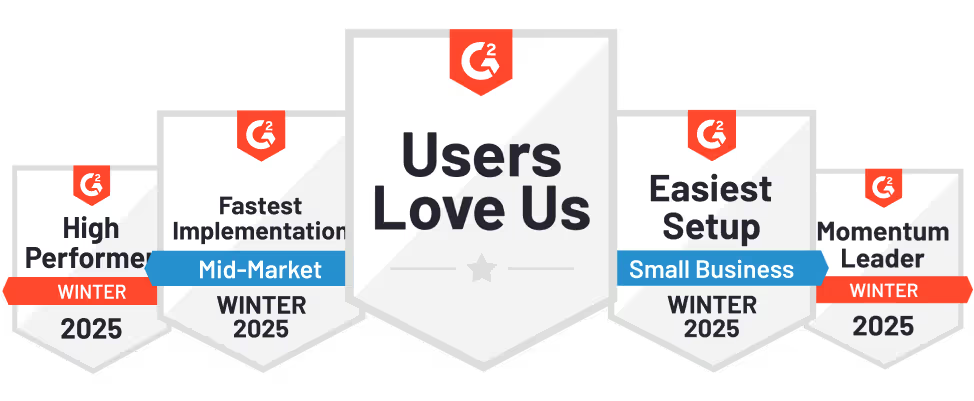
.svg)